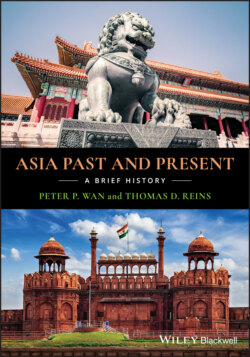Читать книгу Asia Past and Present - Peter P. Wan - Страница 30
Timeline: Ancient China
Оглавление| 1500th century BCE–100th century BCE | Old Stone Age: “Beijing Ape Man” unearthed at Zhoukou Dian 700,000 years ago; hunters and gatherers |
| 100th century BCE–24th century BCE | New Stone Age: Banpo Village ca. 6000 years ago; farmers |
| ca. 2300–2100 BCE | Three ancient kings: Legendary Sage‐Kings Yao, Shun, and Yu |
| ca. 2000 BCE | Bronze Age: Bronze used to make weapons and ceremonial items |
| ca. 2000–1600 BCE | Xia Dynasty: No direct evidence but likely China’s first dynasty |
| ca. 1600–1100 BCE | Peak of China’s Bronze Age; first direct evidence for civilization in China unearthed at Anyang, Henan Province |
| 1046–221 BCE | Shang Dynasty overthrown by Zhou Dynasty, the first recorded dynastic change; China ruled by “Son of Heaven,” whose mandate provides future dynasties political legitimacy |
| 1122–770 BCE | Western Zhou Dynasty: Feudal political order presided over by the Zhou monarchs at Xian capital; introduction of iron upsets ancient political and social order; frontier barbarians force the Zhou rulers to move capital east to Luoyang |
| 770–221 BCE | Eastern Zhou Dynasty: The emergence of numerous political states that challenge both the dynasty and each other, producing ongoing political chaos and intellectual resourcefulness; eventually the State of Qin will end the Warring States period by unifying China in 221 BCE; the Hundred Schools of Thought will deliver basic political and intellectual tools to create China’s bureaucratic model of government that lasts until 1912 CE |
China’s historical records come in a great variety of shapes and forms. The Chinese made written records of their activities on oracle bones, bronze vessels, bamboo strips, silk fabrics, and paper. Their earliest inscriptions on oracle bones date back to 1200 BCE, and their oldest surviving books were written before 500 BCE. Bureaucrats at all levels of government and scribes of powerful clans were consumed with a passion for record keeping. They left behind mountains of records covering population numbers, taxes and revenues, good and bad harvests, floods and droughts and famines, trade, war and peace, diplomatic negotiations, and earthquakes and eclipses. Individuals kept personal accounts, diaries, and collections of poetry and essays. It is not uncommon for an average Chinese family to be able to trace its family tree back many centuries. Private and government‐sponsored discussions had their records as well. Therefore, we have detailed accounts of intense polemics at the highest levels of government on the benefits of government intervention in the marketplace, as well as philosophical debates on the merits of Buddhism and individual autonomy. Historians, poets, and novelists drew epical portraits of their times. Secular and religious art and literature provide in‐depth portrayals of the lives and psyches of China’s people, covering the whole spectrum of humanity from royalty to ordinary people.
Archaeological sites are numerous in China. The remains of imperial palaces and burial sites, temples, villages, private collections of artifacts, and so on serve to round out the modern historian’s knowledge of China’s past. As China’s modernization moves ahead at a dizzy pace, archaeologists are unearthing artifacts that were buried for millennia. Paradoxically, while more and more of China’s past is coming to light, so is more and more of it being destroyed. The discovery of the Qin terra‐cotta armies is an example of the former, and the building of the Three Gorges Dam on the Yangtze River is an example of the latter.
Today, China has the world’s largest population of over 1.4 billion. In other words, one person out of every five living on the face of the earth is Chinese. Its territory is among the largest in the world, being a close fourth after Russia, Canada, and the United States. Its GDP ranks a distant second to that of the United States. It is one of the five permanent members of the Security Council of the United Nations. The role it plays in world affairs is steadily on the increase.
